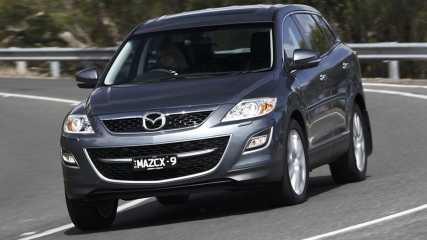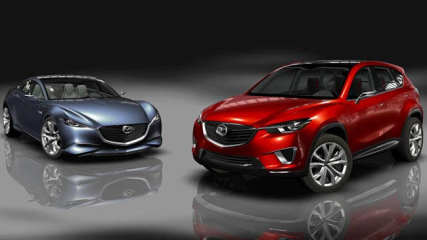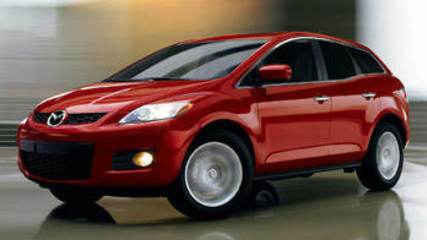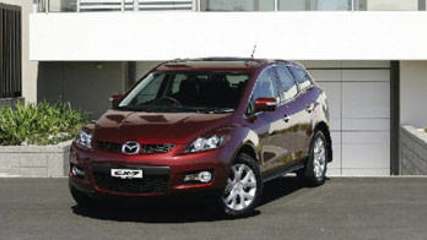Mazda CX-7 2008 News

Mazda, BMW affected again by Takata recalls
Read the article
By Justin Hilliard · 03 Aug 2017
The Australian Competition and Consumer Commission (ACCC) has announced another round of safety recalls, with models from Mazda, Holden, Mercedes-Benz, BMW and Jaguar affected.

Mazda mini SUV
Read the article
By Neil Dowling in Geneva · 03 Mar 2011
It's sitting on the runway in its final countdown before showroom launch but Mazda still won't say much about its "baby" SUV, the CX-5. Chief designer Masashi Nakayama says the car - designed to replace the Tribute on world markets - gave him a clean sheet approach to its design.
But he says it is still influenced by its slightly bigger sister, the CX-7, and even the MX-5 of which he was one of the design team members. Shown in pre-production guise at this week's Geneva motor show, the Minari concept is as close as it's likely to get before Mazda starts pressing the metal body panels.
Surprisingly it's a lot bigger in the flesh than early pictures suggest. Mazda Australia's Steve Maciver says it's only a few centimetres shorter than the CX-7, begging the question that the company now has a chance to build an even smaller SUV to take on rivals such as the Mitsubishi ASX.
Nakayama won't talk about any future product and isn't discussing when it will hit the streets. But he is keen to point out where the car has come from and who it's aimed at.
"There is a huge market in SUVs and especially smaller SUVs,'' he says. "Some of these are too big. This car is the right size and is designed for the driver. t's more like a passenger car in how it drives, but we know the market may be mainly for ladies with children. So the Generation Y woman is the car's target.''
He says he had a free hand with the car and that it is not based on any existing platform. "This is a SkyActiv platform (to be used first on the next Mazda3) and it's the perfect base for the SUV because it is the right size and is designed for sports driving.''
Though the show car is still regarded as a concept, its shape is almost definite. It will lose, however, the pop-out door handles and a lot of the intricate dashboard components.
The SUV was shown at Geneva this week alongside the Shinari concept coupe that shares its new grille and headlight theme. It was finished in a brilliant metallic red that Nakayama says is a special colour reserved for the very best of show cars.
"It doesn't represent the colour of the Japan flag of a rising sun, but of a sun that is high in the sky - in this case high in the SkyActiv technology,'' he smiles.

On the way Subaru Exiga
Read the article
By Neil McDonald · 05 Dec 2008
Subaru Australia managing director, Nick Senior, is close to signing off on the multi-purpose Exiga minivan.

Mazda's latest wagon breezes in
Read the article
By Paul Gover · 28 Jul 2008
The company has just revealed the latest in its series of swoopy concept cars, called the Kazamai, but in reality it is a clear pointer to a CX-5.

Cross purpose
Read the article
By Stephen Corby · 23 May 2008
There was a time when it was quite acceptable for SUVs to handle like a beach ball full of wet porridge, but those days are gone.Outside of men who wear flannelette and fish hooks in their hats, Australian buyers of urban trucks are desperately in awe of “car-like dynamics”.This means that, essentially, they don't want an SUV at all. They just want a really big car with a high chair in it.The modern SUV, typified by Mazda's CX-7, is so much more car than off-roader that it demands a new acronym, Sports Utility Car perhaps — which would provide the plural a bunch of SUCs.Mazda folk have distilled the essence of these vehicles as “a car-like driving experience while retaining command-of-the-road driving position”.The result is something that looks, from front and rear, like a Mazda3 on stilts. Funnily, though, from side on the pinched headlights make it look like a Ford Focus writ large.But you've got to love the shape of the glasshouse, or the “unique window graphic” as they call it. Overall, it's a slick, sleek bit of SUC-ing up.The interior is roomy, rattle-free and reasonably stylish, except for the strange crocodile-skin strip down the middle of the seats, which are comfortable rather than luxurious.Mazda has attempted to create an SUV that goes, and feels, like a sports car — which is like building a snow plough that spits out ice sculptures.Or, as CX-7 program manager Shunsuke Kawasaki novelly puts it, this is a car that's more Keanu Reeves than Arnold Schwarzenegger.A cruel person would take this to mean Kawasaki's creation is a talentless but pretty dullard. He may have been in Speed, but that doesn't mean he's quick.Unfortunately, Kawasaki-san didn't explain whether he meant the Reeves of Bill And Ted fame or his later work (in The Lake House, for example), so it's one to ponder.Fortunately, the car is more convincing than the actor, with a wonderfully taut chassis, minimal body roll for a high-riding vehicle and a handy ride/handling balance, even on rough gravel.Really big impacts do upset it more than a proper off-roader — but you don't get many really big impacts in Woollahra, so that should be fine.The CX-7's steering is also pretty sharp, although it's obviously not in the league of a Mazda6 MPS, for example.It does, however, share that car's engine, a 2.3-litre DISI turbo with 175kW and 350Nm, all of which is available at just 2500rpm, meaning it surges hard — and a little noisily — off the line and accelerates meaningfully. Well, meaningfully for a SUC: the sprint to 100km/h is dismissed in 8.5 seconds.Noise, vibration and harshness are also crushed under the weight of Mazda's technological know-how, although some road noise from the tyres is evident on coarse-chip stuff.And, despite the CX-7's luxurious size and keen performance, we actually saw close to the claimed 11.5 litres per 100km economy figure.This must be because I was driving like an 80-year-old farmer with a hangover — my 11.9 litres per 100km was well and truly trumped by a colleague who recorded 14.9 litres and looked at me with a mixture of pity and disgust.My excuse is that I find driving SUVs, particularly on dirt, as exciting as The Lake House.On proper roads, however, the CX-7 turned out to be roughly seven times more fun than you would think possible.The steering is reasonably involving and it corners quite well, until the point where its size and 1745kg weight eventually push it into understeer.The six-speed auto is a typically Mazda-smooth unit, but it's disappointing that there's no manual option.This is because the CX-7 was (in case you can't guess just by looking) designed for Americans, and their arms are too fat to change gears.The Yanks are also quite happy with a skinny spare wheel — but apparently some Australians do take their SUCs out of the city, because Mazda Australia is doing a special fitting of a full-size spare, which will be available from March.As far as off-road ability goes, this is no low-range mountain-climber. The Active Torque Split AWD system automatically adjusts front-rear distribution between 100:0 and 50:50.In other words, it's a front-wheel-drive bus, but it can grip and rip — at least a little bit — when it needs to.Six airbags and a five-star crash rating from the US make it a safe investment as well.Mazda says the CX-7's competitors will include Toyota's RAV4, Nissan's X-Trail and Murano, and Honda's CRV.The car comes in two trim levels, with the base model a highly competitive $39,910.The $45,560 Luxury version throws in fruit like leather seats, a sunroof, heated power seats and a Bose stereo.Mazda may be a little late on the compact SUV scene, but keen pricing and savvy road manners will make the CX-7 an attractive proposition.It may be a SUC, but the CX-7 doesn't suck.

Gold stars for Mazda CX-7
Read the article
By Mark Hinchliffe · 11 Feb 2008
Side curtain airbags and electronic stability control have helped the new Mazda CX-7 medium SUV score top marks for occupant protection in Australian crash tests.However, it scored only one point for pedestrian protection in the Australasian New Car Assessment Program (ANCAP).The highest pedestrian scores so far have been four stars for the Subaru Impreza and Citroen C6. Pedestrians represented 12 per cent of the Australian road toll last year.Electronic stability control (ESC) has this year become a prerequisite by ANCAP to score five stars. This follows international research that shows a reduction of up to 66 per cent in driver injury in single vehicle crashes where ESV is fitted.About 30 per cent of new passenger vehicles sold in Australia now have stability control.In other ANCAP results, the Toyota Corolla scored four stars and Hyundai Elantra three.RACQ vehicle technologies manager Steve Spalding said the results of some of the volume-selling models were a concern.In Europe, where all Corollas have curtain airbags, it scores five stars.However, Toyota Australia makes them available only on the more expensive variants.“It is difficult to understand why Australian consumers are not provided with similar safety features as standard,” he said.Euro NCAP results for vehicles available here include the Mercedes-Benz C class and Mazda2 (with ESC) scoring five stars.Four stars were awarded to the Mazda2 (without ESC), Kia Rio with side head protecting airbags, Smart fortwo and Nissan X-TRAIL.Kia Rio without side head protecting airbags, Kia Cerato and Hyundai Elantra scored three stars.

Mazdas? SUV gets bigger
Read the article
By Stuart Innes · 22 Nov 2007
The CX-9 is due to hit the showrooms in December, the large SUV will boast a 3.7-litre V6 engine.
In Japanese spec it produces 204kW of power at 6350rpm and 366Nm of torque at 4250rpm.
The Mazda CX-7 uses a 2.3-litre four-cylinder but the turbocharged petrol engine gives 175kW of power. The CX-9 is built on a different platform, having a wheelbase of 2875mm and a total body length of 5074mm.
Mazda says Australia will be the first market to get the 3.7-litre version of the CX-9. It will be available in two grades; Luxury and Classic. Prices are expected to start in the low $50,000s.
The CX-9 will sit on 18 or 20-inch wheels, depending on the version, and have three rows of seats. However, reasonable luggage space will remain; even when the third seating row is in use; 480 litres, which is comparable to a decent-sized normal car boot.
Fold the third seat-row away and there's 928 litres of space to play with.
The second-seat row is split 40-60 and can slide forward and aft 12cm.
Mazda adds a wide door opening for third-row passengers to step in behind the second-row seat.
CX-9s being built for Australia have stability control, roll-stability control, touch-screen audio with reversing camera, six airbags, cruise control, power windows and three-zone, climate-control airconditioning with separate control for the rear.
Mazda's 'active torque split' all-wheel-drive system is used. It will automatically adjust torque distribution to the front and rear wheels from 100 per cent front wheels to 50-50.

Cross purpose
Read the article
By Stephen Corby · 19 Nov 2006
There was a time when it was quite acceptable for SUVs to handle like a beach ball full of wet porridge, but those days are gone.
Outside of men who wear flannelette and fish hooks in their hats, Australian buyers of urban trucks are desperately in awe of “car-like dynamics”.
This means that, essentially, they don't want an SUV at all. They just want a really big car with a high chair in it.
The modern SUV, typified by Mazda's CX-7, is so much more car than off-roader that it demands a new acronym, Sports Utility Car perhaps which would provide the plural a bunch of SUCs.
Mazda folk have distilled the essence of these vehicles as “a car-like driving experience while retaining command-of-the-road driving position”.
The result is something that looks, from front and rear, like a Mazda3 on stilts. Funnily, though, from side on the pinched headlights make it look like a Ford Focus writ large.
But you've got to love the shape of the glasshouse, or the “unique window graphic” as they call it. Overall, it's a slick, sleek bit of SUC-ing up.
The interior is roomy, rattle-free and reasonably stylish, except for the strange crocodile-skin strip down the middle of the seats, which are comfortable rather than luxurious.
Mazda has attempted to create an SUV that goes, and feels, like a sports car which is like building a snow plough that spits out ice sculptures.
Or, as CX-7 program manager Shunsuke Kawasaki novelly puts it, this is a car that's more Keanu Reeves than Arnold Schwarzenegger.
A cruel person would take this to mean Kawasaki's creation is a talentless but pretty dullard. He may have been in Speed, but that doesn't mean he's quick.
Unfortunately, Kawasaki-san didn't explain whether he meant the Reeves of Bill And Ted fame or his later work (in The Lake House, for example), so it's one to ponder.
Fortunately, the car is more convincing than the actor, with a wonderfully taut chassis, minimal body roll for a high-riding vehicle and a handy ride/handling balance, even on rough gravel.
Really big impacts do upset it more than a proper off-roader but you don't get many really big impacts in Woollahra, so that should be fine.
The CX-7's steering is also pretty sharp, although it's obviously not in the league of a Mazda6 MPS, for example.
It does, however, share that car's engine, a 2.3-litre DISI turbo with 175kW and 350Nm, all of which is available at just 2500rpm, meaning it surges hard and a little noisily off the line and accelerates meaningfully. Well, meaningfully for a SUC: the sprint to 100km/h is dismissed in 8.5 seconds.
Noise, vibration and harshness are also crushed under the weight of Mazda's technological know-how, although some road noise from the tyres is evident on coarse-chip stuff.
And, despite the CX-7's luxurious size and keen performance, we actually saw close to the claimed 11.5 litres per 100km economy figure.
This must be because I was driving like an 80-year-old farmer with a hangover my 11.9 litres per 100km was well and truly trumped by a colleague who recorded 14.9 litres and looked at me with a mixture of pity and disgust.
My excuse is that I find driving SUVs, particularly on dirt, as exciting as The Lake House.
On proper roads, however, the CX-7 turned out to be roughly seven times more fun than you would think possible.
The steering is reasonably involving and it corners quite well, until the point where its size and 1745kg weight eventually push it into understeer.
The six-speed auto is a typically Mazda-smooth unit, but it's disappointing that there's no manual option.
This is because the CX-7 was (in case you can't guess just by looking) designed for Americans, and their arms are too fat to change gears.
The Yanks are also quite happy with a skinny spare wheel but apparently some Australians do take their SUCs out of the city, because Mazda Australia is doing a special fitting of a full-size spare, which will be available from March.
As far as off-road ability goes, this is no low-range mountain-climber. The Active Torque Split AWD system automatically adjusts front-rear distribution between 100:0 and 50:50.
In other words, it's a front-wheel-drive bus, but it can grip and rip at least a little bit when it needs to.
Six airbags and a five-star crash rating from the US make it a safe investment as well.
Mazda says the CX-7's competitors will include Toyota's RAV4, Nissan's X-Trail and Murano, and Honda's CRV.
The car comes in two trim levels, with the base model a highly competitive $39,910.
The $45,560 Luxury version throws in fruit like leather seats, a sunroof, heated power seats and a Bose stereo.
Mazda may be a little late on the compact SUV scene, but keen pricing and savvy road manners will make the CX-7 an attractive proposition.
It may be a SUC, but the CX-7 doesn't suck.




